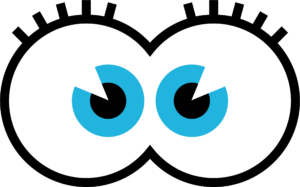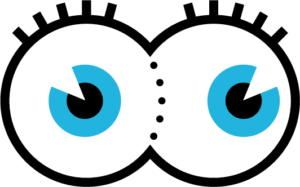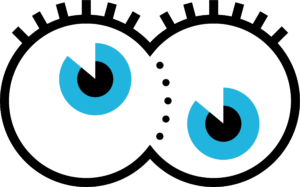 Learn more about eye diseases
Learn more about eye diseases
Strabismus
What is strabismus?
Strabismus is an eye disorder that can be easily identified from childhood. It corresponds to a lack of coordination and misaligned eyes. Normally, the axes of the eyes are parallel when looking both far and near, with both eyes looking at the same object.
In strabismus, this cooperation of the two eyes is compromised. As the child is unable to complain about his double vision, it is important to be vigilant and consult your paediatrician or your ophthalmologist from the first months.
What are signs of a strabismus?
There are different forms of strabismus in children:
- A convergent strabismusor esotropia: one eye is turned inwards and looks more towards the nose, and the child squints.

- A divergent strabismus or exotropia: one eye is turned outwards and looks more towards the temple.

- Vertical strabismus, hyper- or hypotropia: one eye looks too upwards or too downwards.

The deviation may be constant or intermittent, stable or fluctuating, present since childhood or acquired in adulthood. Sometimes the patient complains of double vision, this is called diplopia.
The angle of deviation is sometimes too small to be visible to the naked eye. This is called a “micro-strabismus”, which however has the same consequences as a wider-angle strabismus.
How can strabismus be screened for?
In children, the screening is carried out by the paediatrician who carries out several tests during the check-ups from 0 to 6 months, then at each visit. If the paediatrician or parents notice a strabismus, even intermittent, a consultation with an ophthalmologist is essential.
The presence of infantile strabismus or poor vision (amblyopia) in the family justifies early monitoring by the ophthalmologist, around the age of 1 year, even in the absence of strabismus.
In adults, screening is carried out by an ophthalmologist.
Different ages, different problems
In children, vision is not mature at birth; it develops in the first years of life. If one eye works and sees well, but the other is not well aligned, the brain ignores the image of the deviated eye and only learns to see with the eye that focuses on what the child wants to look at.
The deviated eye does not develop its vision, which remains very poor. This is called amblyopia, or “lazy eye”, which must be treated as soon as possible. In addition, in the presence of strabismus in early childhood, the brain cannot develop binocular vision, that is to say the ability to see in 3D.
In adults: The onset of strabismus in adults is most often accompanied by double vision (diplopia), headaches, and/or significant visual fatigue.
An acquired strabismus can occur as a result of the deterioration of a child’s strabismus. But it can also be the sign of a neurological problem (a stroke for example), which requires urgent investigations.
What are the risk factors?
It is important to check the family history. Cases of infantile strabismus or poor vision in the child’s family represent a slightly higher risk for the child to have strabismus.
Perinatal problems, in particular neurological problems, as well as significant refractive disorders (need for glasses), in particular severe hyperopia, constitute a greater risk of developing strabismus.
What are the treatments for strabismus?
An ophthalmological assessment: we advise you to make an appointment with your ophthalmologist. They will then carry out an eye examination which will define whether the child needs an optical correction or an orthoptic assessment.
In children, treatment usually consists of prescribing glasses, which provide a sharp image to both eyes. Then to hide the “good” eye with a patch (also called occlusion), in order to force the brain to use and learn to see with the deviated eye.
Once the situation has stabilised, an operation can be considered in order to realign the eyes.
An orthoptic assessment: the orthoptist will assess strabismus and, above all, check for possible amblyopia, which corresponds to a delay in the development of vision in one of the two eyes. They will thus support the child in their rehabilitation.
In adults, prism glasses that deflect light or an occlusion can be useful to suppress double vision. After stabilisation, an oculomotor operation (that is to say, of the muscles responsible for the movements of the eye) can be considered.
Find out more about children's visual disorders
Do you want to learn more about a particular visual condition? Discover our pages on myopia, astigmatism, diplopia, and congenital glaucoma. We explain these visual disorders and tell you how to treat them to preserve your children’s visual acuity.
